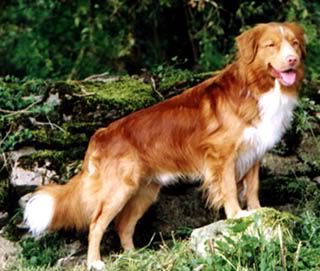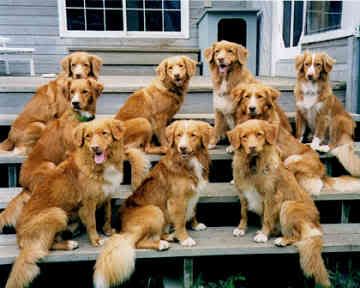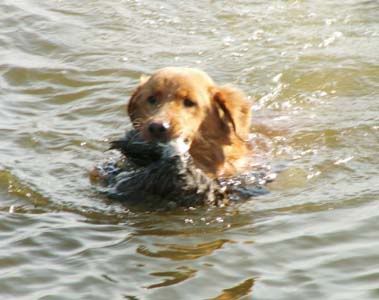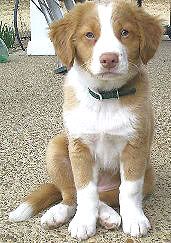Post by DogGoneGood on Dec 30, 2008 14:27:32 GMT -5
Group: I - Sporting
Origin: Canada

Purpose: The Nova Scotia Duck Tolling Retriever was developed in Nova Scotia in the early 19th century to toll (or lure) and retrieve waterfowl. The tolling dog runs, jumps, and plays along the shoreline in full view of a flock of ducks,occasionally disappearing from sight and then quickly reappearing, aided by the hidden hunter, who throws small sticks or a ball for the dog. The dog’s playful actions lure the curious ducks within gunshot range. The dog is then sent to retrieve the downed bird.

General Appearance: The Toller is a medium-sized, powerful, compact, balanced, well-muscled dog; medium to heavy in bone, with a high degree of agility, alertness, and determination. Many Tollers have a slightly sad expression until they go to work, when their aspect changes to intense concentration and excitement. At work, the dog has a speeding, rushing action, with the head carried out almost level with the back and heavily-feathered tail in constant motion.
Coat and Colour:
The Toller was bred to retrieve from icy waters and must have a water-repellent double coat of medium length and softness with a softer, dense undercoat. The coat may have a slight wave on the back, but is otherwise straight. Some winter coats may form a long, loose curl at the throat. Featherings are soft at the throat behind the ears and at the back of the thighs, and forelegs are moderately feathered. While neatening of the ears and feet is permitted, the Toller should always appear natural. Colour is various shades of red or orange with lighter featherings and underside of tail, and usually at least one of the following white markings — tip of tail, feet (not exceeding beyond the pasterns), chest, and blaze. A dog of otherwise high quality is not to be penalized for lack of white. The pigment of the nose, lips and eye rims should match, and be flesh coloured, blending with coat, or be black.
Head:
Skull: the head, which should be in proportion to the body size, is clean-cut and slightly wedge-shaped when viewed from above. The broad skull is only slightly rounded, the occiput not prominent and the cheeks flat. Length from occiput to stop should roughly equal that of stop to tip of nose. The stop is moderate.
Muzzle: tapers in a clean line from stop to nose, with the lower jaw strong but not prominent. The underline of the muzzle runs almost in a straight line from the corner of the lip to the corner of the jawbone, with depth at the stop being greater than at the nose. Hair on the muzzle is short and fine. Whiskers are not removed.
Nose: tapers from bridge to tip, with nostrils well open. Colour should blend with that of the coat or be black.
Mouth: lips fit fairly tightly, forming a gentle curve in profile, with no heaviness in flews. The correct bite is tight scissors, full dentition is required. Overshot by more than 1/8 inch, under shot and wry mouth are highly undesirable. Jaws are strong enough to carry a sizable bird, and softness in mouth is essential.
Eyes: set well apart, almond shaped, medium-sized. Colour, amber to brown. Expression is friendly, alert and intelligent. Flesh around the eyes should be the same colour as the lips.
Ears: triangular, rounded at the tips, medium-sized and carried in a dropped fashion. They are set high and well back on the skull, with the base held very slightly erect so that the edge of the ear is carried to the side of the head. They are well feathered at and behind the fold, with short hair at the tips.
Neck:
Slightly arched, strongly muscled and well set-on, of medium length, with no indication of throatiness.
Forequarters:
Shoulders should be muscular, with the blade well laid back and well laid on giving good withers sloping into the short back. The blade and upper arm are roughly equal in length with the upper arm well angled back under the body. Elbows should be close to the body, turning neither in nor out, working cleanly and evenly. The forelegs should appear as parallel columns, straight and strong in bone. The pasterns are strong and slightly sloping. The strongly-webbed feet are tight and round, with well-arched toes, thick pads and strong nails, and are in proportion to the size of the dog. Dewclaws may be removed.
Body:
Deep-chested with good spring of rib, brisket reaching to the elbow. The back is short and straight, the topline level, the loins strong and muscular. The ribs are well-sprung, neither barrel shaped nor flat. Tuck-up is moderate.
Hindquarters:
Muscular, broad, and square in appearance. Rear and front angulation should be in balance. Thighs are very muscular, upper and lower sections being approximately equal in length. Stifles are well bent and hocks well let down, turning neither in nor out.
Dewclaws must not be present.
Tail:
Following the natural very slight slope of the croup, broad at the base, luxuriant and heavily feathered, with the last vertebra reaching at least to the hock. The tail may be carried below the level of the back except when the dog is alert when it curves high over, though not touching the back.
Gait:
The Toller combines an impression of power with a springy, jaunty gait, showing good reach in front and a strong driving rear. Feet should turn neither in nor out and the legs travel in a straight line. As speed increases, the dog should single-track, topline remaining level, and covering ground with economy of movement.
Faults:
(To be penalized according to degree)
[2] Overshot bite.
[3] Tail too short, kinked or curled over touching the back.
[4] Lack of substance in adult dog.
[5] Dish or down-faced.
[6] Abrupt stop.
[7] Large, round eyes.
[8] Nose, eye rims, and eyes not of prescribed colour.
[9] Bright pink nose.
[10] Splayed or paper feet, down in pasterns.
[11] Open coat.
[12] Roached, sway back, slack loins.
[13] Tail carried below level of back when dog gaiting.
[14] Any departure from the foregoing points should be considered a fault and penalized according to the degree of deviation.
[/ul]
Disqualification:
[2] Silvery coat, grey in coat, black areas in coat.
[3] Lack of webbing.
[4] Undershot bite, wry mouth.
[5] In adult classes, any shyness.
[6] Butterfly nose.
[7] Overshot by more than 1/8 inch.
[8] Any colour other than red or orange shades
[/ul]
Size: Ideal height for males over 18 months is 19-20 inches (48-51 cm); females over 18 months 18-19 inches (45-48 cm). One inch (3 cm) over or under ideal height is allowed. Weight should be in proportion to the height and bone of the dog guidelines: 45-51 lb. (20-23 kg) for adult males; bitches 37-43 lb. (17-20 kg).

Temperment: The Toller is highly intelligent, easy to train, and has great endurance. A strong and able swimmer, he is a natural and tenacious retriever on land and from water, setting himself for springy action the moment the slightest indication is given that retrieving is required. His strong retrieving desire and playfulness are qualities essential to his tolling ability.
Loving and playful to his family, he can be reserved with strangers without being aggressive or overly shy. Aggression is not to be tolerated.

History: Nova Scotia's Duck Tolling Retriever, also called the Little River Duck Dog, has often been hailed as one of Nova Scotia's "best kept secrets". This small tawny reddish dog has an elusive origin and sketchy breeding history, one which Gail MacMillan meticulously sorts through and documents.
First recognized as a distinct breed by the Canadian Kennel Club in 1945, its exact beginnings are a subject for conjecture and legend. MacMillan has pieced together a plausible historical account through her many interviews with the descendants of toller breeders and Yarmouth county residents, her study of letters and journals that make reference to tolling retrievers, and the lineage documentation contained in current breeding records. To this she has added her own insights about the character and traits of this unique breed of dog.
The use of small dogs for tolling is an old tradition, MacMillan explains. Records indicate that this strategy to lure waterfowl was used in ancient Japan. Hunters in Holland, Belgium and France were known to use tolling dogs as early as the fifteenth century. However what distinguishes the Nova Scotia Duck Tolling Retriever from other tolling dogs and animals is that it not only attracts the waterfowl, but it also retrieves them.
Just how this practice first started in Nova Scotia is not exactly known. Some accounts suggest the Little River Duck Dog was specially bred, descending from the mating of retrievers and spaniels with a little Irish Setter thrown into the mix. Others ascribe its origins to a more fanciful theory that it was the resulting progeny of red foxes and dogs.
The first documented account of tolling dogs in Nova Scotia appears in a book (circa 1630) by Nicolas Denys who describes the use of tolling and retrieving dogs by the Acadians. Between Denys' account and the much later twentieth century, legend replaces historical account. Competing family histories credit different people with having originated and developed the breed.
Beginning with Eddie Kenney, a Yarmouth county breeder, who had a penchant for naming dogs "Molly", MacMillan highlights the key breeders and trainers that have played an important role in defining the breed's physical traits and in refining and sharpening the toller's specialised talents.
Through time the unique qualities of this small dog have endeared and fascinated many, inspiring breeder James Jeffery to push for declaring the toller retriever as Canada's National Dog. Although this did not come to pass another toller fancier, Argyle MLA Allister Surette, succeeded in having the breed recognised as Nova Scotia's official dog in 1995. In his address to the legislator Surette remarked, "The Nova Scotia Duck Tolling Retriever is a dog breed worthy to be the Provincial Dog of Nova Scotia. It has over three hundred years of existence in our beautiful province. The good-natured little red dog has a distinct Nova Scotian heritage of which all Nova Scotians can be proud."
Sources:
Canada's Guide to Dogs - Canadian Kennel Club Breed Standard For the Retriever (Nova Scotia Duck Tolling)
Outdoor Nova Scotia: Retriever: A Breed Apart
Origin: Canada

Purpose: The Nova Scotia Duck Tolling Retriever was developed in Nova Scotia in the early 19th century to toll (or lure) and retrieve waterfowl. The tolling dog runs, jumps, and plays along the shoreline in full view of a flock of ducks,occasionally disappearing from sight and then quickly reappearing, aided by the hidden hunter, who throws small sticks or a ball for the dog. The dog’s playful actions lure the curious ducks within gunshot range. The dog is then sent to retrieve the downed bird.

General Appearance: The Toller is a medium-sized, powerful, compact, balanced, well-muscled dog; medium to heavy in bone, with a high degree of agility, alertness, and determination. Many Tollers have a slightly sad expression until they go to work, when their aspect changes to intense concentration and excitement. At work, the dog has a speeding, rushing action, with the head carried out almost level with the back and heavily-feathered tail in constant motion.
Coat and Colour:
The Toller was bred to retrieve from icy waters and must have a water-repellent double coat of medium length and softness with a softer, dense undercoat. The coat may have a slight wave on the back, but is otherwise straight. Some winter coats may form a long, loose curl at the throat. Featherings are soft at the throat behind the ears and at the back of the thighs, and forelegs are moderately feathered. While neatening of the ears and feet is permitted, the Toller should always appear natural. Colour is various shades of red or orange with lighter featherings and underside of tail, and usually at least one of the following white markings — tip of tail, feet (not exceeding beyond the pasterns), chest, and blaze. A dog of otherwise high quality is not to be penalized for lack of white. The pigment of the nose, lips and eye rims should match, and be flesh coloured, blending with coat, or be black.
Head:
Skull: the head, which should be in proportion to the body size, is clean-cut and slightly wedge-shaped when viewed from above. The broad skull is only slightly rounded, the occiput not prominent and the cheeks flat. Length from occiput to stop should roughly equal that of stop to tip of nose. The stop is moderate.
Muzzle: tapers in a clean line from stop to nose, with the lower jaw strong but not prominent. The underline of the muzzle runs almost in a straight line from the corner of the lip to the corner of the jawbone, with depth at the stop being greater than at the nose. Hair on the muzzle is short and fine. Whiskers are not removed.
Nose: tapers from bridge to tip, with nostrils well open. Colour should blend with that of the coat or be black.
Mouth: lips fit fairly tightly, forming a gentle curve in profile, with no heaviness in flews. The correct bite is tight scissors, full dentition is required. Overshot by more than 1/8 inch, under shot and wry mouth are highly undesirable. Jaws are strong enough to carry a sizable bird, and softness in mouth is essential.
Eyes: set well apart, almond shaped, medium-sized. Colour, amber to brown. Expression is friendly, alert and intelligent. Flesh around the eyes should be the same colour as the lips.
Ears: triangular, rounded at the tips, medium-sized and carried in a dropped fashion. They are set high and well back on the skull, with the base held very slightly erect so that the edge of the ear is carried to the side of the head. They are well feathered at and behind the fold, with short hair at the tips.
Neck:
Slightly arched, strongly muscled and well set-on, of medium length, with no indication of throatiness.
Forequarters:
Shoulders should be muscular, with the blade well laid back and well laid on giving good withers sloping into the short back. The blade and upper arm are roughly equal in length with the upper arm well angled back under the body. Elbows should be close to the body, turning neither in nor out, working cleanly and evenly. The forelegs should appear as parallel columns, straight and strong in bone. The pasterns are strong and slightly sloping. The strongly-webbed feet are tight and round, with well-arched toes, thick pads and strong nails, and are in proportion to the size of the dog. Dewclaws may be removed.
Body:
Deep-chested with good spring of rib, brisket reaching to the elbow. The back is short and straight, the topline level, the loins strong and muscular. The ribs are well-sprung, neither barrel shaped nor flat. Tuck-up is moderate.
Hindquarters:
Muscular, broad, and square in appearance. Rear and front angulation should be in balance. Thighs are very muscular, upper and lower sections being approximately equal in length. Stifles are well bent and hocks well let down, turning neither in nor out.
Dewclaws must not be present.
Tail:
Following the natural very slight slope of the croup, broad at the base, luxuriant and heavily feathered, with the last vertebra reaching at least to the hock. The tail may be carried below the level of the back except when the dog is alert when it curves high over, though not touching the back.
Gait:
The Toller combines an impression of power with a springy, jaunty gait, showing good reach in front and a strong driving rear. Feet should turn neither in nor out and the legs travel in a straight line. As speed increases, the dog should single-track, topline remaining level, and covering ground with economy of movement.
Faults:
(To be penalized according to degree)
[2] Overshot bite.
[3] Tail too short, kinked or curled over touching the back.
[4] Lack of substance in adult dog.
[5] Dish or down-faced.
[6] Abrupt stop.
[7] Large, round eyes.
[8] Nose, eye rims, and eyes not of prescribed colour.
[9] Bright pink nose.
[10] Splayed or paper feet, down in pasterns.
[11] Open coat.
[12] Roached, sway back, slack loins.
[13] Tail carried below level of back when dog gaiting.
[14] Any departure from the foregoing points should be considered a fault and penalized according to the degree of deviation.
[/ul]
Disqualification:
[2] Silvery coat, grey in coat, black areas in coat.
[3] Lack of webbing.
[4] Undershot bite, wry mouth.
[5] In adult classes, any shyness.
[6] Butterfly nose.
[7] Overshot by more than 1/8 inch.
[8] Any colour other than red or orange shades
[/ul]
Size: Ideal height for males over 18 months is 19-20 inches (48-51 cm); females over 18 months 18-19 inches (45-48 cm). One inch (3 cm) over or under ideal height is allowed. Weight should be in proportion to the height and bone of the dog guidelines: 45-51 lb. (20-23 kg) for adult males; bitches 37-43 lb. (17-20 kg).

Temperment: The Toller is highly intelligent, easy to train, and has great endurance. A strong and able swimmer, he is a natural and tenacious retriever on land and from water, setting himself for springy action the moment the slightest indication is given that retrieving is required. His strong retrieving desire and playfulness are qualities essential to his tolling ability.
Loving and playful to his family, he can be reserved with strangers without being aggressive or overly shy. Aggression is not to be tolerated.

History: Nova Scotia's Duck Tolling Retriever, also called the Little River Duck Dog, has often been hailed as one of Nova Scotia's "best kept secrets". This small tawny reddish dog has an elusive origin and sketchy breeding history, one which Gail MacMillan meticulously sorts through and documents.
First recognized as a distinct breed by the Canadian Kennel Club in 1945, its exact beginnings are a subject for conjecture and legend. MacMillan has pieced together a plausible historical account through her many interviews with the descendants of toller breeders and Yarmouth county residents, her study of letters and journals that make reference to tolling retrievers, and the lineage documentation contained in current breeding records. To this she has added her own insights about the character and traits of this unique breed of dog.
The use of small dogs for tolling is an old tradition, MacMillan explains. Records indicate that this strategy to lure waterfowl was used in ancient Japan. Hunters in Holland, Belgium and France were known to use tolling dogs as early as the fifteenth century. However what distinguishes the Nova Scotia Duck Tolling Retriever from other tolling dogs and animals is that it not only attracts the waterfowl, but it also retrieves them.
Just how this practice first started in Nova Scotia is not exactly known. Some accounts suggest the Little River Duck Dog was specially bred, descending from the mating of retrievers and spaniels with a little Irish Setter thrown into the mix. Others ascribe its origins to a more fanciful theory that it was the resulting progeny of red foxes and dogs.
The first documented account of tolling dogs in Nova Scotia appears in a book (circa 1630) by Nicolas Denys who describes the use of tolling and retrieving dogs by the Acadians. Between Denys' account and the much later twentieth century, legend replaces historical account. Competing family histories credit different people with having originated and developed the breed.
Beginning with Eddie Kenney, a Yarmouth county breeder, who had a penchant for naming dogs "Molly", MacMillan highlights the key breeders and trainers that have played an important role in defining the breed's physical traits and in refining and sharpening the toller's specialised talents.
Through time the unique qualities of this small dog have endeared and fascinated many, inspiring breeder James Jeffery to push for declaring the toller retriever as Canada's National Dog. Although this did not come to pass another toller fancier, Argyle MLA Allister Surette, succeeded in having the breed recognised as Nova Scotia's official dog in 1995. In his address to the legislator Surette remarked, "The Nova Scotia Duck Tolling Retriever is a dog breed worthy to be the Provincial Dog of Nova Scotia. It has over three hundred years of existence in our beautiful province. The good-natured little red dog has a distinct Nova Scotian heritage of which all Nova Scotians can be proud."
Sources:
Canada's Guide to Dogs - Canadian Kennel Club Breed Standard For the Retriever (Nova Scotia Duck Tolling)
Outdoor Nova Scotia: Retriever: A Breed Apart

